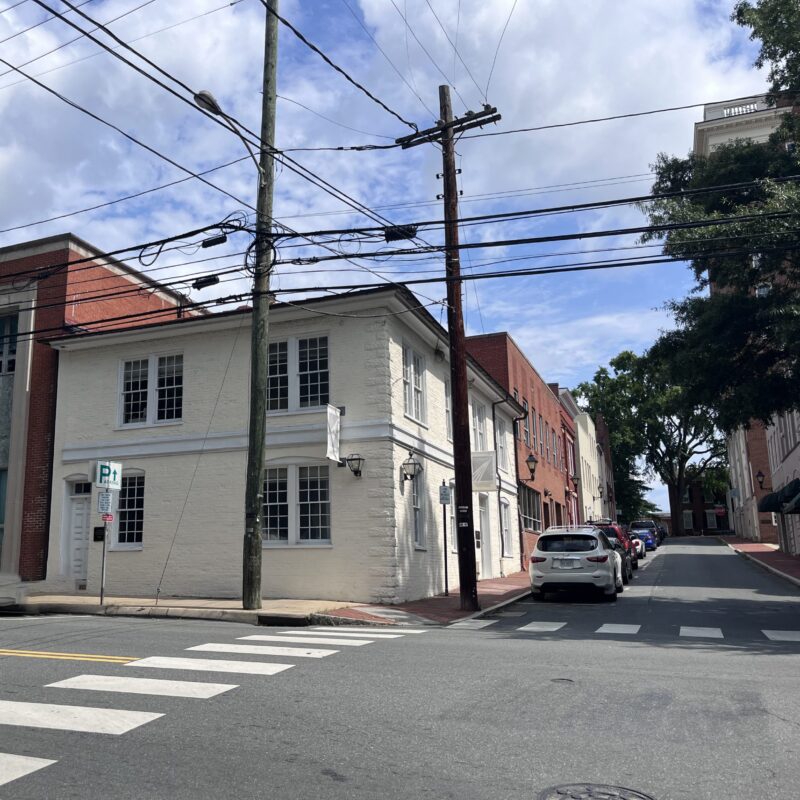| More 2007 year in Review
Nukes, Fines, C.A.R.S., Pigs and parks One new school, gobs of cash, but no A&S dean Rape, murder, kiddie porn and more |
Just because homes sat on the market an average of 92 days and sales dropped to 2003 levels didn’t mean there was nothing to report in 2007. When it came to development coverage this year, several stories we just couldn’t stop writing about, month after month after month.
Biscuit Run: from inconceivable to inevitable in 23 short months
 Biscuit Run was called the "death of humanity" in February, but was approved unanimously by September. |
When word got out in the fall of 2005 that the 1,400 acres of the Breedan property in southern Albemarle, Biscuit Run, had been purchased for development by Hunter Craig and other investors for $46 million, the outrage could hardly be contained. Initial plans called for almost 5,000 housing units, enough to house 10 percent of current area residents. Even when revised plans dropped the count to 3,100 units, locals packed out public meetings, incensed at the "monster," the "death culture devouring everything alive."
But by the time the Board of Supervisors’ decision was made at 1am on September 13, approval seemed all but preordained. About 30 people spoke, a sizeable chunk in favor of Biscuit Run, and the comments of those opposed were more specific and more resigned. What had spurred the turnaround in a mere two years’ time? The $41 million in proffers to offset the infrastructure costs helped entice county officials, and Craig did much to appease individual issues of neighboring property owners, holding hosts of private meetings to work out landscaped buffers and only limited neighborhood connections —he even won, if not the support, at least the neutrality of the usually outspoken Piedmont Environmental Council. But beyond any of that, the decision was also as much the result of time allowing citizens to come to terms with the idea.
So travel south down Old Lynchburg Road and take a long look to your left. In 20 years, when you go visit the grandkids in their Biscuit Run abode, you’ll be able to tell little Johnny, "I remember when…"
NGIC: Deal or no deal (or big deal)?
When 2007 began, we knew that there would be some story involved in the expansion of the Department of Defense’s National Ground Intelligence Center, which was slated to build an addition and bring 800 jobs to the county thanks to a base realignment order. But we didn’t expect as much story as we got. A C-VILLE feature story in March detailing the May 2006 deal between developer Wendell Wood and the county Board of Supervisors turned into a long series of follow-ups that are still ongoing.
The story is convoluted and confusing and worth reading from the beginning if you’re at all interested in the interplay between an aloof federal government, an enterprising businessman and an oft divided group of local leaders elected to do the right thing. But in a nutshell, Wood—who sold NGIC land for their current facility on 29N—told the county he wanted essentially a quid pro quo for selling 47 more acres of his land to NGIC for the supposedly undervalued price of $7 million. The county would keep good jobs that might go to West Virginia or Texas, Wood argued, and in exchange he wanted more of his land moved into the growth area, where it could fetch a better price. The supervisors, after discussions in private meetings, voted 5-1 to pass a "resolution of intent" to move 30 acres of Wood’s land into the growth area.
What had been a relatively quiet affair suddenly became increasingly contentious as the public started asking more questions about what seemed like a cloaked decision. Several supervisors quickly pointed out that a resolution of intent wasn’t binding, and that the matter would still have to pass public hearings on the Places29 master plan. No final decisions have been made, but the Planning Commission so far hasn’t been inclined to agree with moving Wood’s land, and how it plays out in the Places29 hearings will be a story to follow in 2008.
If you build it, they might not come: Big development goes into holding pattern
Despite all this intrigue over future projects, both the city and the county just didn’t seem very interested in growing this year.
In the city, a whole slate of nine-story buildings had cleared the major permitting hurdles and seemed all set. But 12 months later, all of them are still just sketchy renderings and evolving blueprints. Coran Capshaw’s 315-unit Coal Tower project east of the Mall had a site plan approved in August, but major construction hasn’t gotten underway. Bill Atwood’s Waterhouse building started selling units, but still hasn’t started construction. The uber-green 201 Avon St. project turned in plans at the last minute to keep its special use permit alive, but its developers haven’t made a peep otherwise. Keith Woodard put his nine-story Mall project at First Street on hold indefinitely. A Richmond developer wrangled a rezoning out of the city in September to build a 101′-tall building on the corner of McIntire and W. Main Street, but nothing’s happened there beyond the RSC equipment company moving out. It looks like work might begin on the nine-story boutique hotel slated for the former Boxer Learning Center, after original developer Lee Danielson got together with Halsey Minor to buy back the property for $4.5 million that he sold to Oliver Kuttner for $3.7 million. All in all, 2007 was a year of dealing and planning, but not so much a year of construction.
 Wendell Wood had some fun times in the County Office Building this year in association with his plans to lease office space to NGIC. |
Likewise on the county side, mega-developments like Albemarle Place and North Pointe saw no real action, both stalled in part because of sewer infrastructure issues. Old Trail in Crozet is still a long way from being complete. Developers of Belvedere on Rio Road announced a new plan with a "green" focus and soon began burning what’s green on the site (much to the chagrin of neighbors). Housing has continued to sprout up on the moonscape of Hollymead, just above the Target shopping center, but the Town Center‘s real town center didn’t get approved until September 12, which means that it’s probably a few years off before those living in the houses feel like strolling down to the Bonefish Grill.
However, overall the number of county building permits issued in 2007 has gone up from 2006, despite the slumping market. The county had issued 734 new building permits by the end of the third quarter, as opposed to only 575 in all of 2006—which was the lowest total since 1995.
Affordable housing: from talk to (some) action
Had more housing been built this year, perhaps it would have settled the development issue that still won’t go away: affordable housing.
This year, talk seemed to move toward more action, perhaps because a report [pdf] from the Thomas Jefferson Planning District Commission helped define the problem, confirming the paucity of cheap homes and emphasizing that the rental market is deficient by 4,500 units for lower-income residents.
 Lee Danielson and Halsey Minor’s Mall hotel is looking like it could be the first nine-story building to start construction. |
Establishing an expanded housing fund, the city invested more in affordable housing this year, offering an $850,000 loan to help finance private developer Keith Woodard’s purchase of Eugene Williams’ Dogwood Housing, a collection of 73 cheap rentals scattered around the city. The city also pushed for a $350,000 cash proffer from McIntire-West Main developer to help with public housing redevelopment. Housing funds weren’t without their politics, however—a $250,000 "slush fund," established by newly elected City Councilor Satyendra Huja when he directed Neighborhood Development Services, came to light in July that only certain nonprofits were told about.
On the county side, Habitat for Humanity was looking at $3.7 million from Biscuit Run developers for its efforts to redevelop the 371 trailers in the Southwood mobile home park, but county supervisors instead wanted more affordable housing in Biscuit Run proper. Nonetheless, Habitat purchased the 100-acre Southwood property this year and is looking at mixed-income redevelopment starting in about five years.
In October, the county received a report from the first developer to follow its 2004 guidelines that 15 percent of units be affordable in new projects. Avon Park’s developer, Church Hill Homes, sold nine of its 44 units for about $175,000 each, but had some trouble finding eligible buyers.
At the end of the year, the local faith group, IMPACT, was finally able to get the city, county and UVA together for a joint meeting on the affordable housing issue, though the first meeting was a return to the "let’s-define-the-problem" sort. We’ll see if any actionable items come out of the talks as they proceed in 2008.
Supervisor election: It’s the end of the Board as we know it
Another story told and re-told this year (and last) is the Board of Supervisors’ divide on efforts that proponents say would protect the rural areas from the harms of development and that opponents say would take away their property rights. After splitting 3-3 on phasing and clustering in 2006, county leaders split 3-3 again in October on a package of protections designed to limit building in the rural areas.
All those splits could change with new supervisor Ann Mallek having been sworn in on December 21. Mallek supported the rural area protections (though she said during her campaign that she wasn’t in favor of phasing), and she takes the place of David Wyant, who had supported the measures on a concept level, but didn’t support them when it came time to vote. Bickering on the Board may be as vociferous as ever, but 4-2 may take the place of 3-3 when roll is called in 2008.
 The election of Ann Mallek could significantly shift the Board of Supervisor’s stance on rural area protection measures. |
Findings 2007
The public housing at Friendship Court should be safe from redevelopment until at least 2017. With seven projects that would improve infrastructure and promote redevelopment, Crozet is growing up awfully quick. The county expects developers to pay it $17,000 per single family detached house. Deadbeat developers beware—the county has a system to track you. The average age of a construction worker is 47. Threatening to close a road can get you $150,000 in proffer money, as proved by Old Lynchburg Road neighbors. The state legislature still doesn’t trust local government with the ability to charge impact fees. An agricultural exemption allows you to build just about anything, including an elevated road that erodes onto your neighbor’s property. The Hardware Store, bought for $2.5 million, will change inside, but not very much outside. Asking developers to put in a staircase doesn’t mean they’ll do it well, as learned from the conflict at Hollymead over a staircase to nowhere. Development in the rural area still isn’t welcome, even if it’s for soccer.
C-VILLE welcomes news tips from readers. Send them to news@c-ville.com.





